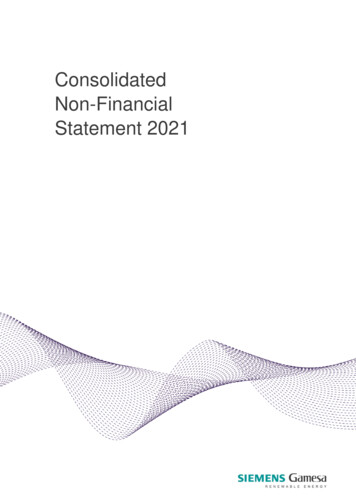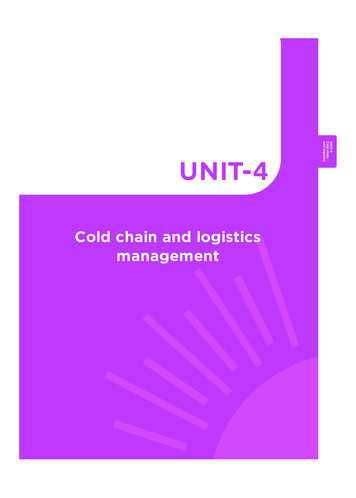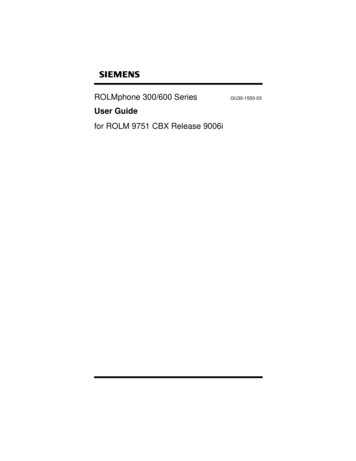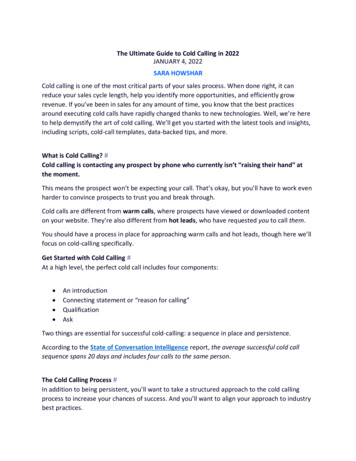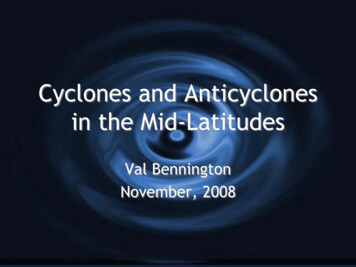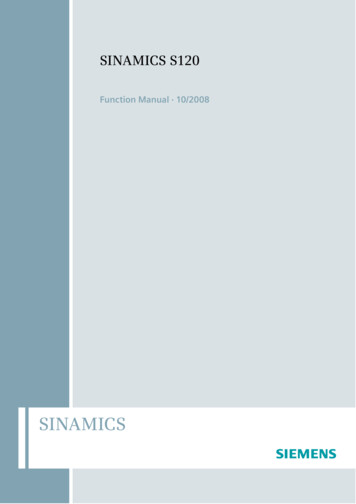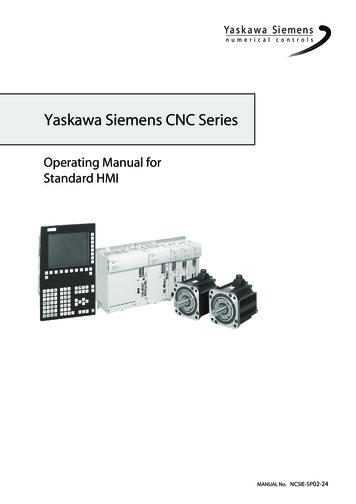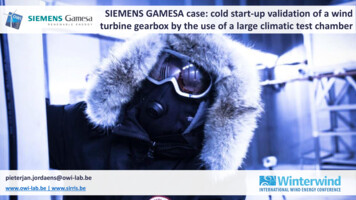
Transcription
SIEMENS GAMESA case: cold start-up validation of a windturbine gearbox by the use of a large climatic test chamberpieterjan.jordaens@owi-lab.bewww.owi-lab.be www.sirris.be
Quick Introduction Sirris & OWI-LabBusiness intelligenceIndustry driven approachwww.offshoreenergycluster.be3 OWI-Lab pillars Set-up in 1949 Belgian Technology center - 160 VTE Mission: to support companies byimplementing technology innovations Multidisciplinary R&D and innovation projects 1.500 innovation projects per yearwith 1.100 different companies (80% SME) RTO partnership focused on onshore andoffshore wind energy topics with the aimto set-up and execute national and internationalRD&I projects22,5 mil revenue Focus on challenges in harsh environments:offshore wind, cold climate wind energyCore topics: Advanced manufacturing ;ICT & data innovation ; Materials engineeringand Mechatronics Core topics: climatic testing facility & reliability in harshenvironments ; SHM ; CMS ; O&M-optimizationwww.sirris.bewww.owi-lab.beR&D andTechnologyExpertiseTest & Demo Lab testing/demo In-field test/demo
OWI-Lab industry services for the wind energy sector Climate chamber testing In-field test /measurement & monitoring projects Offshore and Onshore R&D measurements in general Structural (vibrations, strain, EMA-OMA, ) Machine parameters (thermal, electrical, mechanical) Thermal camera measurements Corrosion / environmental parameters Virtual engineering department FEA model creation / model update / analysis Materials engineering department Coupon material testing, destructive component testing and NDT Failure analysis (RCA) Coating testing Corrosion testing Innovation department RD&I projects (Local funded ; EU-funded) Partnering & clustering Innovation methodology / strategy / implementation
Large climatic test chamber – example projects wind energyFull size component testing of large and heavymachineryFull size small & mid-rangenacelle testsPower electronics testsPitch & Yaw cold startsHydraulic brake testsGenerator testsFull functionalelectrical tests with or withoutwind turbine auxiliaries(forced cooling, pumps,heating, expansion tank, )R&D tests on the behaviorof fluids, oil and hydraulicsin a full functional set-upClimatic test lab Environmental testing of large / heavy electro-mechanical machinery Functional testing under electrical, mechanical, hydraulic load during cold / hot / tropical / Humid environment
Large climatic test chamber – Why ?FMEA Process – Pillay and Wang 2003Design validationChecking if simulation modelsare valid (model validation)Risk mitigationCertificationDeliver reliable machinery shorten the time-to-market
Large climatic test chamber – specifications One of the largest climatic test chambers in the Europe, dedicated forwind turbine components in harsh and extreme climates 10,5m x 7m x 8m inner dimensions Up to 300 ton possible -60 C to 60 C temp testing 8%RH to 95%RH humidity simulation No-load gearbox / generator test bench (cold start testing) IR solar light simulation Ice testing set-up Flexible set of electrical power up to 8MVA Located in the port of Antwerp
Focus (functional) system & sub-system testing
SIEMENS GAMESA case:Cold start-up validation ofa wind turbine gearbox Siemens Gamesa Renewable Energy (SGRE):one of the leaders in manufacturing multi-MWwind turbines (onshore & offshore) SGRE Gearbox Division: design andmanufacturing of WTG gearboxes Worldwide market
SGRE cold climate test: why needed?Last week in Chicago (Jan 2019)
-polar-vortex
(Lubricated ) Machines suffer in low temperature conditionsif not taken into account during the design process of the system
Shell Omala S5 Wind - Outstanding low temperature performancehttps://www.youtube.com/watch?v 2xUipR328rw
Cold climate test in general: why needed?Main topic: low temperature effect on the lubrication side effects if this High viscosity contributes to high churning losses, highpressure drop, and insufficient flow in the lubricationcomponents of the wind turbine gearbox(gears & bearing need sufficient lubrication to prevent wear) Low viscosity causes low film thickness, which increases wear Oil type: finding a balance low temp/high temp limits Preferred oil viscosity is dependent on the environmentaltemperature range of the application cold climate other GBX-oils Cold start-up risk pre-heating needed before starting In general: survivability of the machine in low temperature(pumps, sensors, filters,lubrication, ) duringidling conditions
SGRE cold climate test: why needed? Potential failure modes of a gearbox at extreme cold temperatures Lubricants become viscous and stiff exceptional load on pumping equipment and auxiliaries non-optimal oil flow in bearings Rotating elements at risk insufficient lubrication (non-optimal oil flow) differential thermal expansion of sub components Long cold start-up runs negative effect on energy yield Low temperatures effect materials (plastics, metals, rubbers) brittle fracture of elements (sealings, cables, gears, ) Heaters for oil pre-heating surface temperature of heaters low enough not to burn oil
Overview of most popular measures in “cold climate package”Ice detectionHeated anemometersDedicated low temperaturecooling fluids and cooling circuitFor gearbox, generator & converterIce detection / no-ice detectionBlade de-icing:- Heating mats in composite- Hot air systemHEATING: Additional heaters added to switch cabinets andconverters, gearboxes, hydraulics, anemometer, slip rings,nacelle space FLUIDS: ‘Low temperature’ oils & greases applied – gearbox,bearings, transformer, cooling, hydraulics, MATERIALS: ‘Low temperature’ materials applied(special steel and cast iron alloys for structures ; elastomers) - gearbox,nacelle frame, hub, main shaft, bearing housing, seals, etc SPECIAL MEASURES: Anti & de-icing solutions, improved nacelle sealing, icedetection sensors, dedicated cold start-up procedures (cold climatecontroller), foundation (water ingress)Gearbox:- Special materials- Special lubricants & grease- Additional (pre-) heating- Dedicated cold start-up procedures
Wind turbine applications ‘the misery law’ due to large Δ TAs with lubricating oils, the choice of thickeners can impact cold weatherperformance (Table 2). Typical grease thickeners are lithium soap,aluminum soap, calcium soap, barium soap, and PTFE(polytetraflouroetheylene also known as silicon).Commonly, grease that shows good low-temperature stability will oftenperform poorly in high-temperature applications— requiring grease changeout in warmer weather. Moreover in maritime applications (offshore wind),some additives have a negative environmental impact !
SGRE cold climate test: why needed?Design verification testing (of prototypes) Validate cold start-up procedure (cold sweep test) Time-to-grid (effects of high viscosity of oil on start-up time)Break-away torque (effects of high viscosity of oil on cut in speed)Effects of idling with or without additional heaters (heating strategy)Check auxiliaries components performance in cold conditions(pumps, cooling circuits, filters, sensors, seals, etc)DNVGL-RP-0363 Extreme temperature conditions for wind Turbines (April 2016) survivability testing in full functional set-up Verify performance of new cold temperature oils SGRE end goals of testing: having a reliable & robust machine thatis able to meet with the customers expectations worldwide – evenin the most extreme conditions that can occur Servitization trend: reliability key
SGRE cold climate test set-up2.5 MW wind turbine gearbox
OWI-Lab conclusions of gearbox testing past 5 years All gearbox suppliers and OEM’s are well aware of the risks of low temperatures / cold climates Dedicated mitigation measures taken for these scenario’s (cold climate packages) All of them test & validate their components for extreme environmentsGeneric lessons learned: Validation testing in climate chamber pays off infant failures are early detected & adapted before in-field validation (can be expensive)In general mainly errors with: oil pumps, seals (leakage), cavitation, small components & sensorsAverage time-to-grid time for gearboxes: 5h (with wind) ; early days: x2 or x3Future R&D topics: Cold start-up durability test: accelerated cycles for 20 year lifetime to evaluate the durability of the full systems after X-amount of cold-start cycles( 100 cycles) wear of gears, bearings, winding wear of pumps?Investigation of any correlation between stand-still marks and cold climate regions Develop test in climate chamber for bearingsVirtual testing of cold start-up
Contact person for more in.com/in/pieterjanjordaens/www.owi-lab.be & www.sirris.be
and Mechatronics www.owi-lab.be RTO partnership focused on onshore and offshore wind energy topics with the aim to set-up and execute national and international RD&I projects Focus on challenges in harsh environments: offshore wind, cold climate wind energy Core topics: climatic testing facility & reliability in harsh
